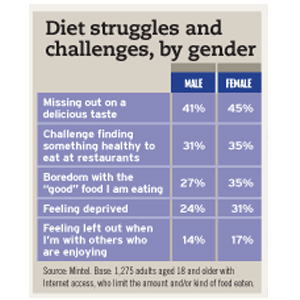Tea innovation creates new drinking occasions
Products focused on unique dayparts encourage consumers to view tea differently

|
In the tea category, some of the most unique new innovations are not just offering consumers new flavors, but creating entirely new drinking occasions for tea as well. “Breakfast tea” has been a common tea variety for years, but some tea companies are creating new drinking occasions with products targeted at other specific times of day. Tea Forté Herbal Retreat Teas, for example, are going after the cocktail hour, while the Republic of Tea’s Cuppa Chocolate Teas are designed as dessert drinks.
Tea Forté’s Herbal Retreat products are promoted as “naturally caffeine-free, organic relaxation teas,” but not of the sink-into-a-hot-bath variety. These teas are formulated for cocktail time and feature flavors such as Blueberry Merlot, Cherry Cosmo, Mojito Marmalade and Apricot Amaretto. Likewise, the Republic of Tea’s Chocolate Red Velvet, Strawberry Chocolate and Coconut Cocoa red tea blends take their cues from cakes and other sweets and are positioned as dessert teas.
Both of the products hail from the U.S., but the concept also is being used in other markets. In Japan, Suntory introduced an After-Meal Luxury Oolong Tea last fall for after-dinner occasions. Poland’s Loyd Tea found inspiration in the alcohol market for its Mulled Wine Teas in Raspberry, Cherry & Raspberry, Forest Charm and Citrus Mulled Wine varieties.
In a market crowded with health claims, the idea of placing tea in drinking occasions that previously were reserved for alcohol or sweet treats can help new teas stand out and help increase tea consumption overall.
Dessert For Dieters
Certain tea varieties already are strongly associated with specific times of day. Nearly half of U.S. tea drinkers, for example, say freshly brewed hot tea is consumed as a morning beverage. Similarly, more than half of herbal tea drinkers in the U.K. say they make a good evening drink. The new teas are expanding those associations with references to desserts or to alcohol drinks.
Chocolate-flavored teas make the easiest connections to dessert occasions. As tea products have far fewer calories than hot chocolate, they also can be positioned as healthier dessert alternatives. The Republic of Tea products, for example, have no sugar or calories. Even if consumers decide to sweeten the products on their own, they can decide which sweeteners to use and how much.
The ability to indulge in sweets is important to consumers who are watching their weight. Nearly three-quarters of U.S. consumers who are trying to manage their diet say it is important to treat themselves occasionally to stay happy. That number is 12 percent higher for women than men (78 percent versus 66 percent), which offers even further opportunities to target specific consumer groups.
In addition, consumers report their most frequent dieting challenges as missing out on a delicious taste, feeling deprived and feeling left out when others are enjoying food.
That’s not to say dessert teas have to be marketed as “diet” products. In fact, that would detract from their indulgent profile. But tea-makers certainly have an opportunity to emphasise that their indulgent flavor comes without calories and sugar, and that consumers can choose the products guilt free.
Foodservice Opportunities
As indicated in the figure to the left, a third of consumers say one of the challenges to dieting is finding something healthy to eat at restaurants. A quarter of U.S. consumers currently order either hot tea or iced tea in restaurants, and expanding the tea menu to dessert occasions can increase those rates.
In addition, consumer research in the U.K. shows many consumers have been unwilling to give up the post-meal coffee purchase, despite recession-related cutbacks in restaurant purchases overall. The ritualistic aspects of the after-dinner coffee or tea could be expanded with menu innovation that emphasizes dessert flavors.
According to Mintel Menu Insights, when consumers are asked which menu items they would like to see more of, smaller desserts and bite-sized desserts are cited by nearly a quarter of fine-dining consumers.
The desire for small dessert items in restaurants speaks to consumers’ need to treat themselves, even if it is just a taste of something decadent. Dessert teas could be paired with these scaled-down items or added to dessert menus as indulgent flavor options that offer a taste of something sweet as an alternative to a full-fledged dessert. BI
Looking for a reprint of this article?
From high-res PDFs to custom plaques, order your copy today!






